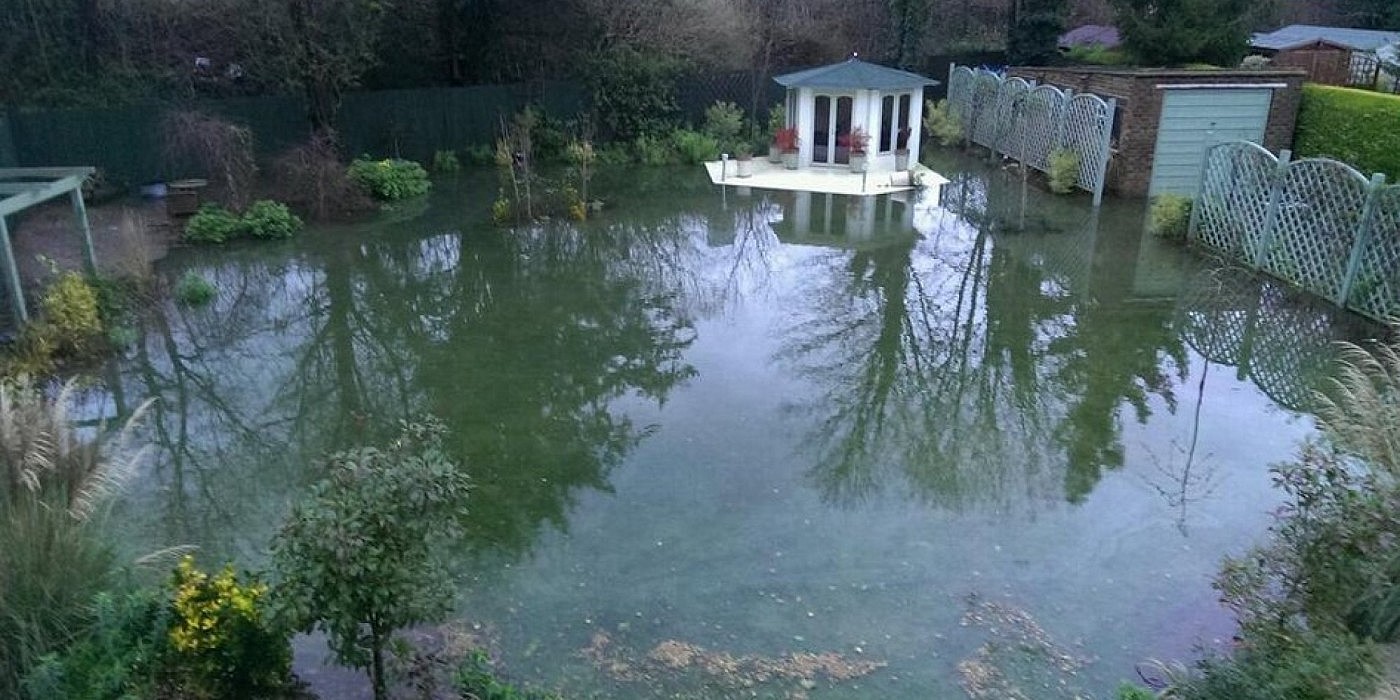Believe it or not, plants can drown
Thankfully most of us, experience the effects of flooding on an irregular basis, so if a flood warning has been issued and you think you might be affected, here are a few things you can do before hand to minimise the impact.
Before the flood
- Un-plug all electrical appliances and move them to somewhere safe from the flood as well as anything that contains a liquid that could contaminate the water, such petrol, oil, paint pots, weed killers, white spirit and any other chemical that you use. You should also move any bags of compost you have to a safe place because once they have been contaminated by flood water, they should not be used due to the pollutants that might be in the water. It is not uncommon for raw sewage to float about.
- Turn off the water supply to the garden in case the pipe gets damaged
- Board up your patio doors and green house to protect the glass from being broken by the water which will also minimise the amount of silt and debris that could be deposited there.
 Harvest anything you can from the vegetable garden now because once it has been covered with flood water, it is inadvisable to eat it because you have no idea what contaminants have come in contact with it.
Harvest anything you can from the vegetable garden now because once it has been covered with flood water, it is inadvisable to eat it because you have no idea what contaminants have come in contact with it.- Move all pots, garden furniture, compost bins, dust bins and ornaments out of harms way. Not only do you protect the actual item but you are also reducing the amount of free floating things that can cause damage.
- Pot up your most favourite perennials or those with sentimental value and move them somewhere safe.
- If you have a fish pond, put netting over it securely to prevent the fish and plants being washed away.
- Tie up all climbers securely and check that newly planted plants are securely in the ground.
- Check old walls and banks and shore the bases up with sand bags if possible. Sand bag any entrances that it would be effective to do so and improvise with compost bags, rubbish bags or anything else filled with soil if necessary. Use the sand from the children’s sand pit, if they have one because you will have to dispose of it anyway after the flood. You could also scrape up and use bark chips or gravel from the paths as this is more than likely to be dispersed by the flood waters.
- Weigh man-hole covers down with anything that’s water-proof and heavy because water can come up through the drainage system and the last thing you want to do is to step into an open hole that is hidden from view by flood water.
Once your garden has flooded
At this point there is little you can do except keep your fingers crossed so the key is to try and think ahead and rescue your most favourite plants in advance. If the worst happens and you are affected by flood water, here’s what to do in the aftermath. Due to the possibility of contaminants in the flood water, always wear water proof gloves when cleaning up.
- Keep to the paths and stay off all soil and the lawn until the water has drained fully away. This is because walking on water-logged soil will compact it by destroying its structure, which you will have to work very hard later on to restore. This is particularly important if you already have a heavy clay soil.
- If you do have to leave the path, put down a board, plank or create temporary stepping stones, with spare bricks.
- Although it is not a good idea to do any digging in water logged soil, if you have a particularly favourite plant it would mean a lot to you to lose that you didn’t manage to rescue before the water rose, dig a trench round its roots to help speed up drainage. This should only be used for plants it would be very difficult or impossible to replace because you will compact a lot of other soil in doing this.
- Wash all silt and debris off the leaves of plants with clean water if rain doesn’t do it for you within a month. If silt is allowed to remain on the leaves, it will prevent the plant from making full use of the sun which will reduce its ability to make food and therefore, thrive. If possible, wash the silt and debris off the lawn as well.
- Aerate the lawn with a hollow tine aerator or else use your garden fork to create small holes into the turf. This will help with drainage and getting air back into the root zone. You could just leave the holes or brush lawn sand in.
- Once the soil has drained fully and is back to its normal texture, apply a generous top-dressing of well-rotted organic matter to help return the soil to good fertility because, depending on the length the floodwater was there for, earthworms and other soil organisms could have been drowned.
- To help boost soil fertility quickly and get the plants going you could also give the plants an application of a general purpose fertilizer once growth restarts.
- Have a good look to see whether the receding water has created a cap on the soil. If so, break it up with a fork.
- If any produce from the vegetable garden was covered by the flood, it is advisable not to eat it because you have no idea what contaminants might also have been in the water.
- If you think the flood has killed anything, you can check by scraping back a little of the bark on the stem and having a look. If the plant is alive, it will be green underneath. Don’t condemn a plant too quickly but if it is any version of brown, it is dead.
Raised beds
Its very difficult to give recommendations about the best plants to have that will survive flooding because it all depends on how long the waters remain. If you live in an area that floods regularly, you would lose less of your plants by having them in raised beds which will drain quicker when the waters recede. They can be made of brick, wood or recycled plastic and are straight forward to construct, either be made from scratch and a bit of DIY know-how or by using a prepared kit.
Contrary to popular belief, raised beds don’t have to be that high to be effective. If you are considering building one or two, don’t think that they have to be feet high because even a raised bed of 15 – 20 cms (6 – 8 inches) is better than not having it at all.
Want to know more?
If you enjoyed this article and want to learn more then feel free to contact me. I’d also appreciate it if you would share this article by clicking any of the social media links at the top of this page.


